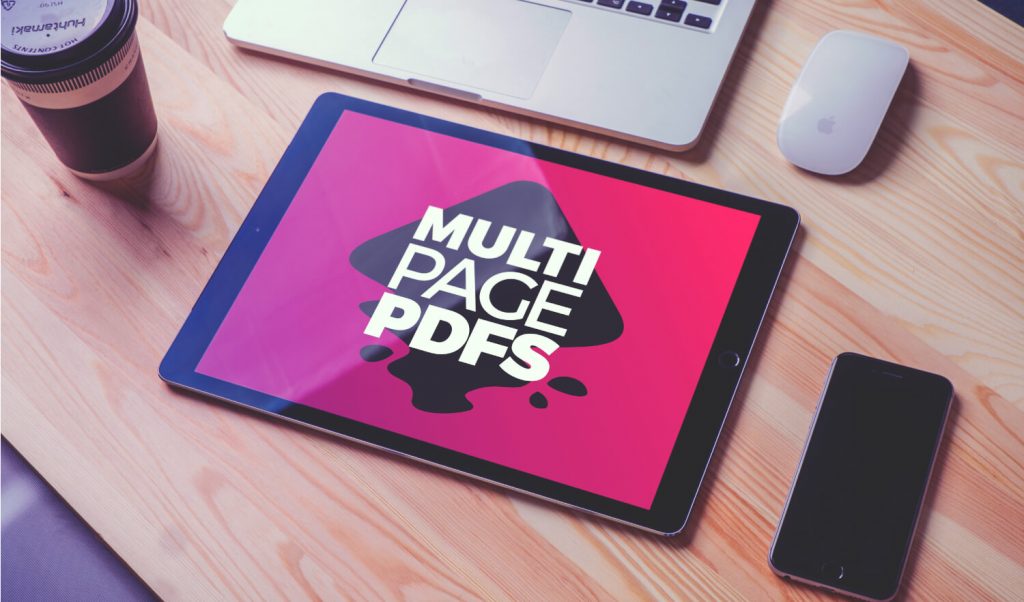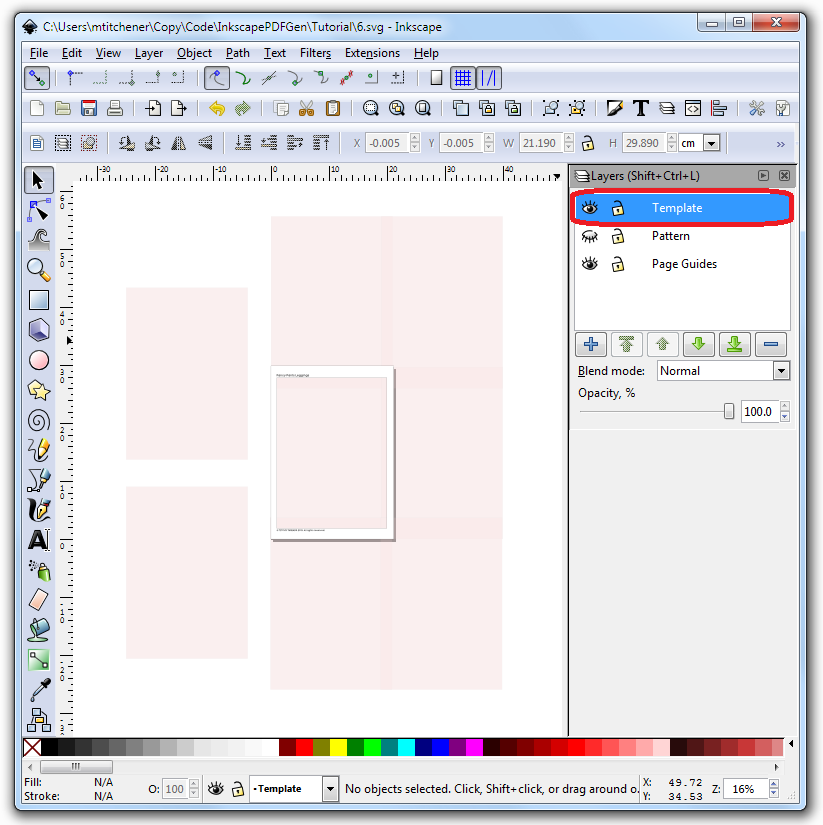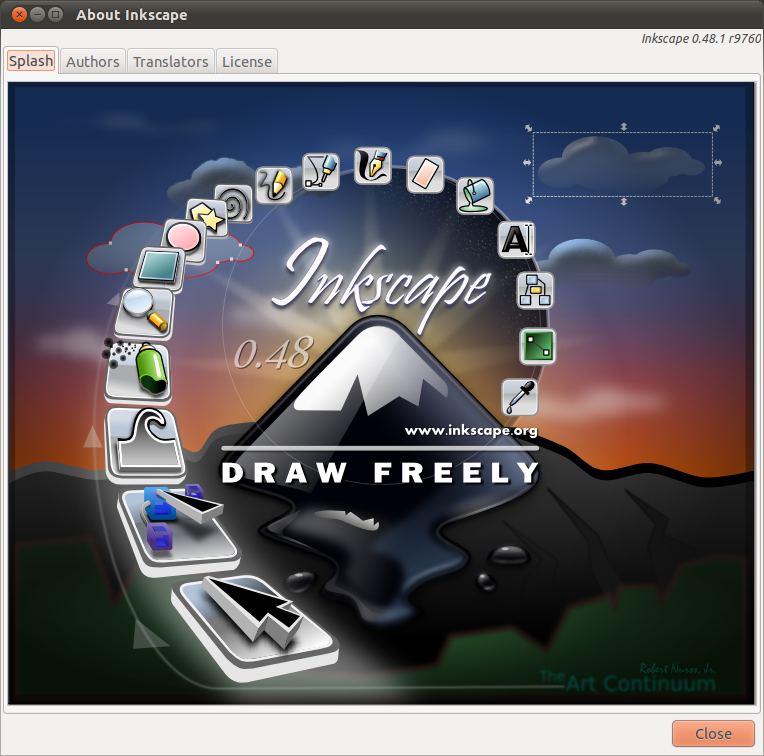Name
Inkscape - an SVG (Scalable Vector Graphics) editing program.
Synopsis
'inkscape [options] [filename ..]'
Once you import it, our PDF page will show as an Inkscape one, where each image will be embedded (if you select that option) and each text line will be an editable box. I haven’t search for editing options for files that have more than one page, however, if I have to, be sure I will do another article. Inkscape is a free and open-source vector graphics editor, similar to Adobe Illustrator and CorelDRAW. It can be used to create and edit vector graphics including illustrations, logos and line arts. Inkscape stands out in the market due to its use of SVG—an open XML-based W3C standard—as the native format. It’s used across a.
options:
Description
Inkscape is a GUI editor for Scalable Vector Graphics ( SVG ) format drawing files, with capabilities similar toAdobe Illustrator, CorelDraw, Xara Xtreme, etc. Inkscape features include versatile shapes, bezier paths, freehand drawing, multi-linetext, text on path, alpha blending, arbitrary affine transforms, gradient and pattern fills, node editing, many export and import formats includingPNG and PDF , grouping, layers, live clones, and a lot more. The interface is designed to be comfortable and efficient forskilled users, while remaining conformant to GNOME standards so that users familiar with other GNOME applications canlearn its interface rapidly.
SVG is a W3C standard XML format for 2D vector drawing. It allows defining objects in the drawing using points, paths,and primitive shapes. Colors, fonts, stroke width, and so forth are specified as 'style' attributes to these objects. The intent is that sinceSVG is a standard, and since its files are text/xml, it will be possible to use SVG files in a sizeable number of programs andfor a wide range of uses.
Inkscape uses SVG as its native document format, and has the goal of becoming the most fully compliant drawing program forSVG files available in the Open Source community.
Options
-?, --help

The --verb command will execute a specific verb as if it was called from a menu or button. Dialogs will appear if that is part of the verb. To get a list ofthe verb IDs available, use the --verb-list command line option.
The --select command will cause objects that have the ID specified to be selected. This allows various verbs to act upon them. To remove allthe selections use --verb=EditDeselect. The object IDs available are dependent on the document specified to load.
inkscape --print='| ps2pdf - mydoc.pdf' mydoc.svg
 GUI , and save the document, then later you will be able to reexport that shape to the same file with the same resolution simply with
GUI , and save the document, then later you will be able to reexport that shape to the same file with the same resolution simply withinkscape -i path231 -t document.svg
If you use --export-dpi, --export-width, or --export-height with this option, then the DPI hint will be ignored and the value from thecommand line will be used. If you use --export-png with this option, then the filename hint will be ignored and the filename from the command line will beused.
Inkscape Pdf Editor

With this parameter, Inkscape will enter an interactive command line shell mode. In this mode, you type in commands at the prompt and Inkscape executesthem, without you having to run a new copy of Inkscape for each command. This feature is mostly useful for scripting and server uses: it adds no newcapabilities but allows you to improve the speed and memory requirements of any script that repeatedly calls Inkscape to perform command line tasks (such asexport or conversions). Each command in shell mode must be a complete valid Inkscape command line but without the Inkscape program name, for example 'file.svg--export-pdf=file.pdf'.
Display a brief usage message. Superior drummer 3 demo download.
Configuration
The main configuration file is located in ~/.config/Inkscape/preferences.xml; it stores a variety of customization settings that you can change in Inkscape(mostly in the Inkscape Preferences dialog). Also in the subdirectories there, you can place your own:
$HOME/.config/Inkscape/extensions/ - extension effects.
$HOME/.config/Inkscape/icons/ - icons.
$HOME/.config/Inkscape/keys/ - keyboard maps.
$HOME/.config/Inkscape/templates/ - new file templates.
Diagnostics
The program returns zero on success or non-zero on failure.
A variety of error messages and warnings may be printed to STDERR or STDOUT . If the program behaves erratically with aparticular SVG file or crashes, it is useful to look at this output for clues.
Examples
While obviously Inkscape is primarily intended as a GUI application, it can be used for doing SVG processing on thecommand line as well.
Open an SVG file in the GUI:Print an SVG file from the command line:Export an SVG file into PNG with the default resolution of 90dpi (one SVG user unit translates to one bitmappixel):Same, but force the PNG file to be 600x400 pixels:Same, but export the drawing (bounding box of all objects), not the page:Export to PNG the object with, using the output filename and the resolution that were used for that object last time when itwas exported from the GUI:Same, but use the default 90 dpi resolution, specify the filename, and snap the exported area outwards to the nearest whole SVG user unitvalues (to preserve pixel-alignment of objects and thus minimize aliasing):Convert an Inkscape SVG document to plain SVG:Convert an SVG document to EPS , converting all texts to paths:Query the width of the object with:Duplicate the object with, rotate the duplicate 90 degrees, save SVG , and quit:
Environment
DISPLAY to get the default host and display number.
TMPDIR to set the default path of the directory to use for temporary files. The directory must exist.
Themes
To load different icons sets instead of the default $PREFIX/share/inkscape/icons/icons.svg file, the directory$HOME/.inkscape/icons/ is used. Icons are loaded by name (e.g. fill_none.svg), or if not found, then from icons.svg. If the iconis not loaded from either of those locations, it falls back to the default system location.
The needed icons are loaded from SVG files by searching for the SVG id with the matching icon name. (For example, to load the'fill_none' icon from a file, the bounding box seen for SVG id 'fill_none' is rendered as the icon, whether it comes from fill_none.svgor icons.svg.)
Other Info
The canonical place to find Inkscape info is at http://www.inkscape.org/. The website has news, documentation, tutorials, examples, mailing listarchives, the latest released version of the program, bugs and feature requests databases, forums, and more.
See Also
potrace, cairo, rsvg(1), batik, ghostscript, pstoedit.
SVG compliance test suite: http://www.w3.org/Graphics/SVG/Test/
SVG validator: http://jiggles.w3.org/svgvalidator/
Scalable Vector Graphics ( SVG ) 1.1 Specification W3C Recommendation 14 January 2003 <http://www.w3.org/TR/SVG11/>
Edit Multi Page Pdf Inkscape Manual Pdf
Scalable Vector Graphics ( SVG ) 1.2 Specification W3C Working Draft 13 November 2003 <http://www.w3.org/TR/SVG12/>
SVG 1.1/1.2/2.0 Requirements W3C Working Draft 22 April 2002 <http://www.w3.org/TR/SVG2Reqs/>
Document Object Model ( DOM ): Level 2 Core Arnaud Le Hors et al editors, W3C<http://www.w3.org/TR/DOM-Level-2-Core/>
Gui Notes
To learn Inkscape's GUI operation, read the tutorials in Help > Tutorials.
Apart from SVG , Inkscape can import (File > Import) most bitmap formats ( PNG , BMP , JPG ,XPM , GIF , etc.), plain text (requires Perl), PS and EPS (requires Ghostscript),PDF and AI format ( AI version 9.0 or newer).
Inkscape exports 32-bit PNG images (File > Export) as well as AI , PS , EPS ,PDF , DXF , and several other formats via File > Save as.
Inkscape can use the pressure and tilt of a graphic tablet pen for width, angle, and force of action of several tools, including the Calligraphic pen.
Inkscape includes a GUI front-end to the Potrace bitmap tracing engine (http://potrace.sf.net) which is embedded into Inkscape.
Inkscape can use external scripts (stdin-to-stdout filters) that are represented by commands in the Extensions menu. A script can have a GUIdialog for setting various parameters and can get the IDs of the selected objects on which to act via the command line. Inkscape comes with an assortment ofeffects written in Python.
Keybindings
To get a complete list of keyboard and mouse shortcuts, view doc/keys.html, or use the Keys and Mouse command in Help menu.
Bugs
Many bugs are known; please refer to the website (inkscape.org) for reviewing the reported ones and to report newly found issues. See also the Known Issuessection in the Release Notes for your version (file ' NEWS ').
Authors
This codebase owes its existence to a large number of contributors throughout its various incarnations. The following list is certainly incomplete, butserves to recognize the many shoulders on which this application sits:
Maximilian Albert, Josh Andler, Jean-François Barraud, Bill Baxter, John Bintz, Arpad Biro, Nicholas Bishop, Joshua L. Blocher, Henrik Bohre, Boldewyn,Daniel Borgmann, Bastien Bouclet, Gustav Broberg, Christopher Brown, Hans Breuer, Marcus Brubaker, Luca Bruno, Nicu Buculei, Bulia Byak, Ian Caldwell, GailCarmichael, Ed Catmur, Chema Celorio, Johan Ceuppens, Zbigniew Chyla, Alexander Clausen, John Cliff, Kees Cook, Ben Cromwell, Robert Crosbie, Jon Cruz, AurélieDe-Cooman, Milosz Derezynski, Daniel DÃaz, Bruno Dilly, Larry Doolittle, Tim Dwyer, Maxim V. Dziumanenko, Johan Engelen, Miklos Erdelyi, Ulf Erikson, NoéFalzon, Frank Felfe, Andrew Fitzsimon, Edward Flick, Marcin Floryan, Fred, Ben Fowler, Cedric Gemy, Steren Giannini, Olivier Gondouin, Ted Gould, Toine deGreef, Michael Grosberg, Bryce Harrington, Dale Harvey, Aurélio Heckert, Carl Hetherington, Jos Hirth, Thomas Holder, Joel Holdsworth, Alan Horkan, Karl OveHufthammer, Richard Hughes, Nathan Hurst, inductiveload, Thomas Ingham, Jean-Olivier Irisson, Bob Jamison, jEsuSdA, Lauris Kaplinski, Lynn Kerby, Niko Kiirala,James Kilfiger, Jason Kivlighn, Adrian Knoth, Krzysztof Kosin'ski, Petr Kovar, Raph Levien, Diederik van Lierop, Nicklas Lindgren, Vitaly Lipatov, IvanLouette, Colin Marquardt, Dmitry G. Mastrukov, Matiphas, Michael Meeks, Federico Mena, MenTaLguY, Aubanel Monnier, Tim Mooney, Derek P. Moore, Peter Moulder,Jörg Müller, Yukihiro Nakai, Victor Navez, Christian Neumair, Andreas Nilsson, Mitsuru Oka, Marten Owens, Alvin Penner, Jon Phillips, Zdenko Podobny, AlexandreProkoudine, Jean-René Reinhard, Alexey Remizov, Frederic Rodrigo, Hugo Rodrigues, Juarez Rudsatz, Xavier Conde Rueda, Felipe Corrêa da Silva Sanches, AurélioA. Heckert, Christian Schaller, Marco Scholten, Tom von Schwerdtner, Shivaken, Michael Sloan, Danilo Å egan, BoÅ¡tjan Å peticˇ, Aaron Spike, Kaushik Sridharan,Ralf Stephan, Dariusz Stojek, Pat Suwalski, Adib Taraben, Hugh Tebby, Jonas Termeau, David Turner, Andre Twupack, Aleksandar UroÅ¡evic', Lucas Vieites, MichaelWybrow, Daniel Yacob, David Yip, Masatake Yamato
This man page was put together by Bryce Harrington <brycehar@bryceharrington.com>.
History
The codebase that would become Inkscape began life in 1999 as the program Gill, the GNOME Illustrator application, created by Raph Levien.The stated objective for Gill was to eventually support all of SVG . Raph implemented the PostScript bezier imaging model, including strokingand filling, line cap style, line join style, text, etc. Raph's Gill page is at http://www.levien.com/svg/. Work on Gill appears to have slowed or ceased in2000.
The next incarnation of the codebase was to become the highly popular program Sodipodi, led by Lauris Kaplinski. The codebase was turned into a powerfulillustration program over the course of several year's work, adding several new features, multi-lingual support, porting to Windows and other operatingsystems, and eliminating dependencies.
Inkscape was formed in 2003 by four active Sodipodi developers, Bryce Harrington, MenTaLguY, Nathan Hurst, and Ted Gould, wanting to take a differentdirection with the codebase in terms of focus on SVG compliance, interface look-and-feel, and a desire to open development opportunities to moreparticipants. The project progressed rapidly, gaining a number of very active contributors and features.
Much work in the early days of the project focused on code stabilization and internationalization. The original renderer inherited from Sodipodi was lacedwith a number of mathematical corner cases which led to unexpected crashes when the program was pushed beyond routine uses; this renderer was replaced withLivarot which, while not perfect either, was significantly less error prone. The project also adopted a practice of committing code frequently, and encouragingusers to run developmental snapshots of the program; this helped identify new bugs swiftly, and ensure it was easy for users to verify the fixes. As a result,Inkscape releases have generally earned a reputation for being robust and reliable.
Similarly, efforts were taken to internationalize and localize the interface, which has helped the program gain contributors worldwide.
Inkscape has had a beneficial impact on the visual attractiveness of Open Source in general, by providing a tool for creating and sharing icons, splashscreens, website art, and so on. In a way, despite being 'just an drawing program', Inkscape has played an important role in making Open Source more visuallystimulating to larger audiences.
Copyright And License
Copyright © 1999-2008 by Authors.
Inkscape is free software; you can redistribute it and/or modify it under the terms of the GPL .
Referenced By
inkview(1),scribus(1)Size of this JPG preview of this PDF file: 423 × 599 pixels. Other resolutions: 169 × 240 pixels | 339 × 480 pixels | 424 × 600 pixels | 542 × 768 pixels | 1,239 × 1,754 pixels. |

Original file (1,239 × 1,754 pixels, file size: 3.92 MB, MIME type: application/pdf, 143 pages)
Captions

Captions
Summary[edit]
| Description | English: This is a free, user-editable, open source Inkscape software manual. |
| Date | |
| Source | http://en.flossmanuals.net/Inkscape/FM_Inkscape_18Oct08.pdf |
| Author | en.flossmanuals.net |
Licensing[edit]
| This work is free software; you can redistribute it and/or modify it under the terms of the GNU General Public License as published by the Free Software Foundation; either version 2 of the License, or any later version. This work is distributed in the hope that it will be useful, but without any warranty; without even the implied warranty of merchantability or fitness for a particular purpose. See version 2 and version 3 of the GNU General Public License for more details. |
This PDF graphic was created with Inkscape.
File history
Click on a date/time to view the file as it appeared at that time.
| Date/Time | Thumbnail | Dimensions | User | Comment |
|---|---|---|---|---|
| current | 16:23, 30 December 2008 | 1,239 × 1,754, 143 pages (3.92 MB) | Econt(talk | contribs) | {{Information |Description={{en|1=This is a free, user-editable, open source Inkscape software manual.}} {{pt-br|1=Manual para o Inkscape}} |Source=http://en.flossmanuals.net/Inkscape/FM_Inkscape_18Oct08.pdf |Author=en.flossmanuals.net |Date=2008 |Permiss |
File usage on Commons
The following page uses this file:
File usage on other wikis
The following other wikis use this file:
- Usage on cs.wikiversity.org
- Usage on pt.wikibooks.org
Metadata
Structured data


